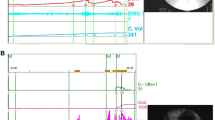Abstract
Introduction and hypothesis
To assess the prevalence of vesico-ureteral reflux (VUR) and upper urinary tract damage in women with idiopathic high-pressure detrusor overactivity (IHPDO) and to characterize their bladder function.
Methods
A retrospective chart review of women diagnosed with IHPDO (detrusor pressures > 40 cm H2O during involuntary bladder contractions) from 2007 to 2010 was conducted. Women were assessed for VUR by X-ray voiding cysto-urethrogram. Renal ultrasound or CT urogram, serum BUN/creatinine, and urinalyses were performed if reflux reached the renal pelvices. Cystometric and voiding pressure study data were reviewed for detrusor overactivity pressure and volume, voiding dysfunction, urethral relaxation, compliance, and bladder outlet obstruction.
Results
Sixty-five women were diagnosed with IHPDO, and 50 completed an X-ray voiding cysto-urethrogram. The median (range) detrusor overactivity pressure was 65 (41–251) cm H2O. Four (8.0 %) women had IHPDO; none had upper urinary tract deterioration. The majority of women exhibited urethral relaxation with voiding, impaired compliance, and bladder outlet obstruction.
Conclusions
Women with IHPDO are at risk of low-grade vesico-ureteral reflux. However, most women with IHPDO are likely protected from reflux by intermittent exposure to high detrusor pressures and the ability to decompress the bladder by urethral relaxation.
Similar content being viewed by others
References
McGuire EJ, Woodside JR, Borden TA (1983) Upper urinary tract deterioration in patients with myelodysplasia and detrusor hypertonia: a followup study. J Urol 129:823–826
Wang SC, McGuire EJ, Bloom DA (1988) A bladder pressure management system for myelodysplasia-clinical outcome. J Urol 140:1499–1502
Flood HD, Ritchey ML, Bloom DA, Huang C, McGuire EJ (1994) Outcome of reflux in children with myelodysplasia managed by bladder pressure monitoring. J Urol 152:1574–1577
Lenoardo CR, Filgueiras MFT, Vasconcelos MM, Vasconcelos R, Marino VP, Pires C, Pereira AC, Reis F, Oliveira EA, Lima EM (2007) Risk factors for renal sparring in children and adolescents with lower urinary tract dysfunction. Pediatr Nephrol 22:1891–1896
Kurzrock EA, Polse S (1998) Renal deterioration in myelodysplastic children: urodynamic evaluation and clinical correlates. J Urol 159:1657–1661
Ghoneim GM, Roach MB, Lewis VH, Harmon EP (1990) The value of leak point pressure and bladder compliance in the urodynamic evaluation of meningomyelocele patients. J Urol 144:1440–1442
Houser EE, Bartholomew TH, Cookson MS, Marlin AE, Little NA (1994) A prospective evaluation of leak point pressure, bladder compliance and clinical status in myelodysplasia patients with tethered spinal cords. J Urol 151:177–181
McGuire EJ, Woodside JR, Borden TA, Weiss RM (1981) Prognostic value of urodynamic testing in myelodysplastic patients. J Urol 126:205–209
Haylen BT, de Ridder D, Freeman RM, Swift SE, Berghmans B, Lee J, Monga A, Petri E, Rizk DE, Sand PK, Schaer GN (2010) An International Urogynecological Association (IUGA)/International Continence Society (ICS) joint report on terminology for female pelvic floor dysfunction. Int Urogynecol J 21:5–26
Stohrer M, Blok B, Catro-Diaz D, Del Popolo F, Kramer G, Radziszewski P, Reitz A, Wyndaele JJ (2009) EUA guidelines on neurogenic lower urinary tract dysfunction. Eur Urol 56(1):81–88
Smith AL, Jaffe WI, Wang M (2012) Detrusor overactivity leak point pressure in women with urgency incontinence. Int Urogynecol J 23(4):443–446
Lebowitx RL, Olbing H, Parkkulainen KV, Smellie JM, Tamminen-Mobius TE (1985) International system of radiographic grading of vesicoureteric reflux. International Reflux Study in Children. Pediatr Radiol 15:105–109
Abrams P, Cardozo L, Fall M, Griffiths D, Rosier P, Ulmsten U, van Kerrebroeck P, Victor A, Wein A (2002) The standardization of terminology of lower urinary tract function: report from the Standardisation Sub-committee of the International Continence Society. Neurourol Urodyn 21:167–178
Ghoniem GM, Bloom DA, McGuire EJ, Stewart KL (1989) Bladder compliance in meningomyelocele children. J Urol 141:1404–1406
Blaivas JG, Groutz A (2000) Bladder outlet obstruction nomogram for women with lower urinary tract symptomatology. Neurourol Urodyn 19:553–564
Sjostrom S, Jodal U, Sixt R, Bachelard M, Sillen U (2009) Longitudinal development of renal damage and renal function in infants with high grade vesicoureteral reflux. J Urol 181:2277–2283
Webb RJ, Griffiths CJ, Ramsden PD, Neal DE (1992) Ambulatory monitoring of bladder pressure in low compliance neurogenic bladder dysfunction. J Urol 148:1477–1481
Harris RL, Cundiff GW, Theofrastous JP, Bump RC (1996) Bladder compliance in neurologically intact women. Neurourol Urodyn 15:483–488
Acknowledgements
We would like to acknowledge the assistance of Hongyan Du, MS (NorthShore University HealthSystem Center for Clinical Research and Informatics) in performing the sample size and power calculation.
Funding
None.
Financial disclaimers/conflicts of interest
Adam Gafni-Kane: none; Peter K. Sand is an advisor for Allergan, Astellas, Ferring, Pfizer, and Uroplasty.
Author information
Authors and Affiliations
Corresponding author
Rights and permissions
About this article
Cite this article
Gafni-Kane, A., Sand, P.K. Vesico-ureteral reflux in women with idiopathic high-pressure detrusor overactivity: prevalence, bladder function, and effect on the upper urinary tract. Int Urogynecol J 25, 1405–1410 (2014). https://doi.org/10.1007/s00192-014-2380-3
Received:
Accepted:
Published:
Issue Date:
DOI: https://doi.org/10.1007/s00192-014-2380-3




